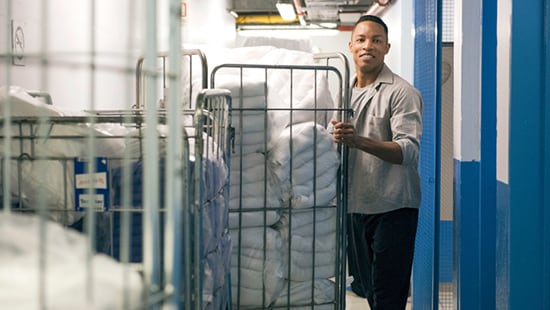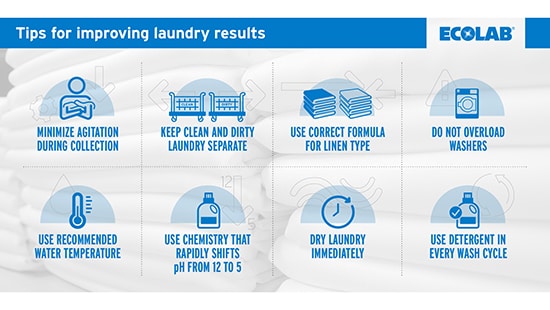More Than Chemistry: The Keys to Hygienically Clean Laundry

As Ecolab fought to help protect those visiting and working in hotels, schools, senior living communities, fitness centers and other public spaces from the COVID-19 virus throughout 2020, hygienic cleanliness took on new importance and an elevated interest.
We worked with customers to reevaluate and revamp cleaning, disinfecting and sanitizing procedures across their operations — and this included laundry operations. Many people understand the role clean laundry can play in the comfort of guests, residents and workers, but may not realize the importance it plays to help keep people safe.
As a senior chemist and laundry expert at Ecolab, I’m often asked how to help reduce the spread of infection within laundry operations. The answer is multi-faceted, but one thing is for sure: it takes more than chemistry, even if a detergent has hygienic clean claims. Every stage of the linen flow cycle — from collection to washing and drying to storage — presents opportunities to help promote hygienically clean linen and safer laundry environments. Let’s take a look at the keys to hygienically clean laundry operations, starting with some background on the terminology.
What does it mean to have a hygienically clean laundry process?
Most people have heard the term hygienically clean but may not know what it means. It isn’t the same as disinfection, which refers to the complete killing of bacteria and viruses. It’s also different from sanitization, which refers to a significant reduction in the number of bacteria. Products with sanitization or disinfection claims require rigorous testing and registration by the Environmental Protection Agency (EPA)1
There is actually no universal definition for hygienically clean, but the one used most often and by the Association for the Advancement of Medical Instrumentation (AAMI) is “free of pathogens (bacteria, viruses and germs) in sufficient numbers to cause human illness.”2 EPA regulates products if they sanitize or disinfect. Ecolab has EPA registered products for sanitizing and disinfecting linen if an additional level of protection is needed.
Why hygienically clean laundry matters
Many businesses and organizations, including many of our customers, rely on reusable fabrics such as towels, sheets and table linens to help run safe, successful operations. Providing hygienically clean laundry can benefit your business in a variety of ways. Beyond removing unpleasant odors and the hygienically clean linens can help reduce skin irritation and discomfort.
In short, hygienically clean laundry can help to prevent negative experiences — from guests, residents or staff — that could impact not only their wellbeing, but the business’s performance and reputation.
How to achieve hygienically clean
It’s important to follow proper procedures across the entire laundry process, from collection, transport and sorting all the way through washing, drying, storage and preparing for use. There are critical steps in each procedure that can help create and maintain hygienically clean linen.
Through my daily work with customers, I’ve helped them overcome a wide range of challenges to improve laundry results. Operations and specific needs vary, but here are some areas where I frequently see opportunities for improvement or receive a lot of questions:
- Wash your hands often and correctly. Wash hands and change gloves between handling dirty and clean linen.
- In the collection process, I often hear concerns about shaking laundry. The Centers for Disease Control and Prevention (CDC) recommends minimum agitation and not “hugging” dirty or soiled linens.
- Mixing clean and dirty linens can impact laundry cleanliness. It’s a best practice to clearly label areas to help keep dirty and clean linens separate.
- Remember that different linen types require different formulas. Sort items by type and color and select the correct formula for better results.
- Clean and disinfect hard surfaces that linen comes in contact frequently including the front washer and dryer surfaces, as well as any other contact areas.
- I often see people overload machines to save time. This can actually have the opposite effect. Be sure to load properly based on the machine being used and the training provided. Overloading washers will not produce the desired results.
- Hygienically clean linen can be achieved in different water temperatures, but it is most critical that the linen is washed in the recommended temperature for the product being used.
- I sometimes see wet or damp laundry sitting which can impact cleanliness. It’s important to dry laundry immediately after washing, using the appropriate time and temperature.
- Finally, the number one thing I see that impacts cleanliness is customers running wash cycles without detergent. It’s important for operators to get in the habit of checking chemical levels before starting cycles. Providing signage and other reminders can help prevent running wash cycles without detergent.
While using the right products along with proper procedures is key to achieving hygienically clean linens, there are many other considerations to help promote health and safety across your laundry operations. It’s important to work with providers who partner with you to provide procedure guidance, gather data and insights, look for risks and train your team to help optimize your program.
With heightened expectations for cleaner, safer spaces, it’s important to maintain the momentum gained during the pandemic and keep hygienically clean laundry procedures as a key part of your effort to advance safer, positive experiences for those you employ and serve.

Tips for Improving Laundry Results
1. Series 810 - Product Performance Test Guidelines. The final Product Performance Test Guidelines are generally intended to meet testing requirements for the effectiveness of pesticide products under FIFRA.
2. Hygienically clean is ‘free of pathogens of sufficient numbers to cause human illness’ Association for the Advancement of Medical Instrumentation, ANSI/AAMI ST 65:2008, Processing of reusable surgical textiles for use in health care facilities, 2008, Arlington, VA



